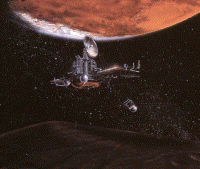

Phobos Project Information
Launch Date: 07 July 1988 (Phobos 1) and 12 July 1988 (Phobos 2)
Launch Vehicle: Proton-K
Mass: 2600 Kg (6220 Kg with orbital insertion hardware attached)
Power System: Solar panels
Phobos 1, and its companion spacecraft Phobos 2, were the next-generation in the Venera-type planetary missions, succeeding those last used during the Vega 1 and 2 missions to comet P/Halley. The objectives of the Phobos missions were to:
The main section of the spacecraft consisted of a pressurized toroidal electronics section surrounding a modular cylindrical experiment section. Below these were mounted four spherical tanks containing hydrazine for attitude control and, after the main propulsion module was to be jettisoned, orbit adjustment. A total of 28 thrusters (twenty-four 50 N thrusters and four 10 N thrusters) were mounted on the spherical tanks with additional thrusters mounted on the spacecraft body and solar panels. Attitude was maintained through the use of a three-axis control system with pointing maintained with sun and star sensors.
Phobos 1 operated nominally until an expected communications session on 2 September 1988 failed to occur. The failure of controllers to regain contact with the spacecraft was traced to an error in the software uploaded on 29/30 August which had deactivated the attitude thrusters. This resulted in a loss of lock on the Sun, resulting in the spacecraft orienting the solar arrays away from the Sun, thus depleting the batteries.
Phobos 2 operated nominally throughout its cruise and Mars orbital insertion phases, gathering data on the Sun, interplanetary medium, Mars, and Phobos. Shortly before the final phase of the mission, during which the spacecraft was to approach within 50 m of Phobos' surface and release two landers, one a mobile 'hopper', the other a stationary platform, contact with Phobos 2 was lost. The mission ended when the spacecraft signal failed to be successfully reacquired on 27 March 1989. The cause of the failure was determined to be a malfunction of the on-board computer.
Phobos 1 experiments
Phobos 2 experiments
Phobos 2 data sets
Mars Fact Sheet
Mars Frequently Asked Questions